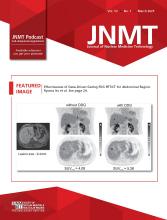Abstract
The administration accuracy and precision of automated infusion device for positron-emitting radiotracer is directly associated with bias and variance in standardized uptake values (SUV) of 18F-FDG PET/CT. Therefore, the accuracy of such devices must be confirmed and calibrated at locations where they are used. The present study aimed to validate the administration accuracy of three automated infusion devices for quantitative PET assessment. Methods: Temporal variations as well as variations in radioactive concentrations and dispensed volumes of 18F-FDG were determined for the M-130, the AI-300 (both Sumitomo Heavy Industries Ltd., Japan), and the UG-05 (Universal Giken Co. Ltd., Japan) automated infusion devices. The total test dispensed volumes were 25, 20 and 18.5 mL, respectively. A reference value was generated by measuring amounts of radioactivity using a standard dose calibrator. Administration accuracy was validated according to the criteria of the Japanese Society of Nuclear Medicine (JSNM). Results: Temporal variation in the M-130 and UG-05 for specified 185 MBq was a relatively stable in the range -1.60 to 0.92% and 1.16 to 5.35%, respectively, whereas that in the AI-300 was -0.55 to 8.68%. For M-130 and UG-05, the difference between measured and reference value was in the range -5 to 5%. The values measured by the AI-300 deviated from the reference values by a maximum of 30%, which depends on radioactive concentration and dispensed volume of 18F-FDG. Conclusion: The administration accuracy of the AI-300 varied considerably under different conditions, but a software update might somewhat improve this. Our findings indicate that dispensed volumes of 18F-FDG should be carefully considered when the radioactive concentration is high. Administration accuracy should be regularly confirmed at each location to maintain the quality of quantitative PET assessment. The present study provides useful information about how to confirm the administration accuracy of automated infusion devices.







